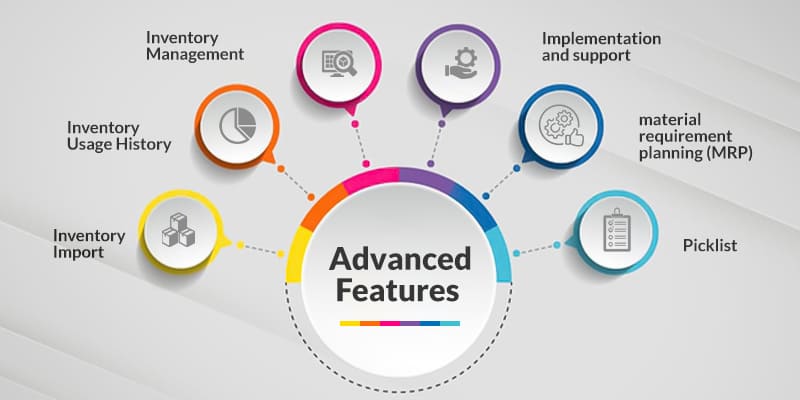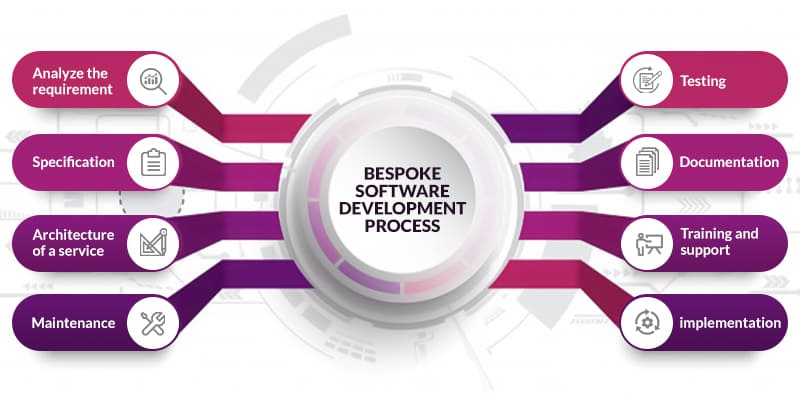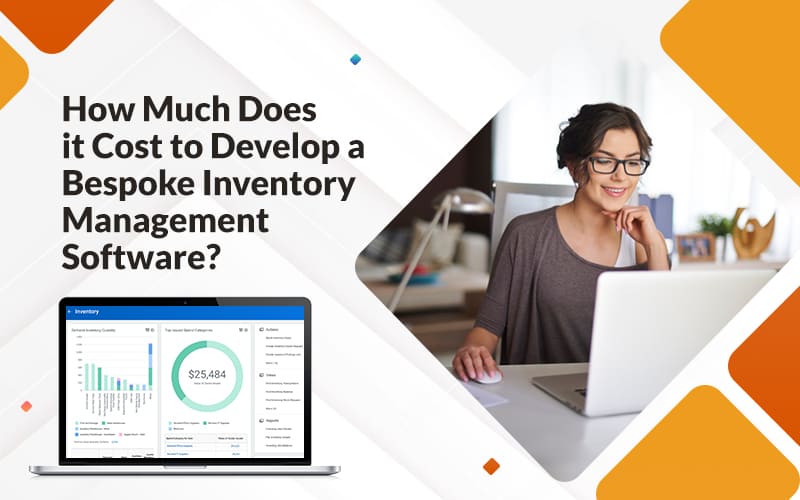How to develop bespoke inventory management software?
Inventory is undoubtedly a company’s biggest asset. Inventory management is among the most key functions in any sector, whether manufacturing, retail, healthcare, or any other. Keeping inventory control is just as vital as procuring it for running an effective and successful business, but bad inventory management is among the leading causes of business failure. Fortunately, there’s a solution that can help you handle your inventory more effectively, saving time and resources. Bespoke inventory management software is a set of tools that helps companies and businesses keep track of their inventory.
The Inventory management software allows businesses and companies to keep track of all incoming and outgoing stocks to satisfy consumer demand better and prevent overstocking or losing business due to stock-outs. Accounting, manufacturing, inventory management, ordering, distribution, and customer support were just a few of the activities impacted by the bespoke inventory management software development. Inventory management software is capable of even more. However, each company and business have its requirements.
This blog will give you everything you need to know about developing bespoke inventory management software. We’ll also go over the main features that your inventory management system must provide to increase productivity and brand equity.
So, let’s start with some fundamentals!
What is Inventory Management Software?
Inventory management software tracks, schedules, and plans all aspects of inventory in cleartext. It aids productivity, saves time and resources, and offers insightful perspectives that help businesses succeed even more. Now businesses will focus on assessing, identifying, and convey oversight in their process by using inventory management software solutions rather than spending time and money on simple monitoring.
As per Zion’s market analysis, the global inventory management software market was worth 2.1 billion dollars in 2018 and is projected to hit 3.2 billion dollars by 2025, rising at a CAGR of considerably more than 6.1 percent.
As numbers say that the opportunity is tremendous. You can get started by developing your bespoke inventory management software by the best bespoke developers.
Moving on, let’s check
Why is Inventory Management Software Important for Businesses?
Inventory management software help you handle your existing stock better, but it could also help you reduce bottlenecks in your value stream. Businesses can reduce costs, ramp up delivery, and increase overall performance by correctly tracking every component in their inventory. Besides, Inventory management software determines how you operate your company or business, represent your customers and increase revenues. Also, stock, deliveries, and other details are monitored in real-time with cloud-based inventory management software. This makes it easier for the team to work together. Your inventory data will be available from anywhere via cloud-based apps, which is a massive advantage for businesses with branches and storage all over the globe.
Apart from that, inventory management software keeps records of your resources and offers real-time data that helps you correctly predict and schedule and deal with manufacturers and distributors. It can assist you in determining which products are common, are, and aren’t, resulting in increased consumer visits and a positive view of your service.
You could accurately determine which items you’ll need with a robust inventory management system. It’s necessary to keep track of your inventory as you expand and target how many ways you want to transform inventory each year. This insight will help you plan more efficiently, boost your earnings, and invest more time in advancement.
Who can use Inventory management software?
Inventory management software is used in a variety of sectors and business models. There are many companies that must maintain and keep a record of inventory items. Below are some sectors which can use inventory management software to streamline their daily operations. So, take a look!
- Retail Industry
- Healthcare Industry
- Manufacturing Industry
- Small, medium, large-sized businesses & Companies
Moving on, let’s discuss some,
Benefits of Inventory Management Software Development
The following are some of the benefits that bespoke inventory management software development can have for you and your company or business. So, take a look!
- Reduce holding costs and increase margins by eliminating shortfalls that result in losing stock, overstocking, and markdowns
- Ensures remote inventory management
- Enhances Productivity
- Lessen Storage and Insurance Expenses
- With adequate business needs analysis, the software can provide technical support 24 hours a day, 7 days a week.
- Enhances customer satisfaction
- Helps to increase sales during peak seasons
- Effective theft or loss reduction
- Resources costs can be saved by reducing the time and manpower expended on inventory administration
Moving on, Technology features of inventory management systems target specific industries, service offerings, and product categories. In the following section, you’ll catch a glimpse of the key features and functionalities to incorporate in your bespoke inventory software development. So, let’s dive in!
What are the key features to include during bespoke inventory management software development?

Here are key features which you need to consider in your inventory management software:
- Reporting – Inventory management software will also assist businesses in learning more about their overall operations. Sales figures, reorder rates, and other data are intelligently recorded, providing invaluable insight. Companies may use these reports to improve order times and keep track of their most common items.
- Purchase Order Management – Build, modify, and send purchase orders that drastically alter inventory levels while maintaining data consistency. Reorder reports can also be produced, so you know when and how to order more product.
- Count Cycles – Cycle counting is a daily process of counting specific data that substitutes the tedious and error-prone periodic physical inventory with the full schedule of measuring more essential ones more frequently than less prominent numbers. Cycle counting’s advantage is that it offers a method for finding and removing the cause of the error to increase accuracy over time.
- Barcodes – Barcodes are an essential functionality that really can help you build your inventory management performance. Business owners can check a product, which instantly categorizes it and pays for it in the inventory, by applying barcodes to every item.
- List Management – Managing commodity prices is critical to a company’s success. Specific price sheets in multiple currencies for various consumer groups, product ranges, zones, and so forth can all be managed with inventory management software.
- Inventory Optimization – You will also have the correct inventory quantity at the right moment with an inventory management system. Computerized predictive analytics, inventory optimization, and reorder points will help you optimize your business processes.
- Auto Ordering – When stock runs out of storage, inventory management software will immediately recognize it and change the product quantity in your inventory. If a specific product is in great supply, this will help the company maintain an acceptable quantity of inventories and address customer demand.
- Multi warehouse control – Inventory management becomes more difficult if you have several warehouses or storage facilities. The best inventory management software can move to several locations and provide information on stock position and volume. It would also make moving stock from one location to another much more effortless.
- Track Serial – Inventory planners can add a code to each commodity and monitor its movement from the time of purchase to the point of sale using serial number tracking. This functionality will offer customers feedback and encouragement that their package is on its move if orders are disrupted or if they want to monitor where their order is.
- Create Sales Report – Promptly access and produce reliable sales data that provide information for better business decisions. You can create sales data and order reports by client, product, channel, venue, and more to do with the inventory management software.
Since we’ve discussed the functionality, now let’s move on to the important part of this blog. That is!
How to develop bespoke inventory management software? Key development steps!

The following are the steps to take when preparing a strategy to build inventory management software.
1. Evaluate your idea
Evaluating your project’s objectives and reach clarifies your plans for the project and helps you identify your desired end state. Evaluating the project scope, identifying possible ways for the proposed system to meet business goals and objectives, resource allocation, cost-related timelines, and evaluating solutions are all part of the comprehensive planning process of software development.
2. Do requirement analysis
Once you’ve established your objectives, you can figure out what you’ll need to get there. Other facets of your project would be defined by the specifications, such as the team, resources, time, expertise, and budget needed. Requirement’s analysis also aids in the early identification of threats, allowing risk reduction techniques to be devised from the outset. Both the development team and the clients benefit from clear, organized documentation because it facilitates collaboration and knowledge.
3. Select the right tech stack
The technology stack is made up of all the languages, libraries, and frameworks used to build your software during development. It’s essential to define them ahead of time because you’ll need to know what skills your development team might have. This part will undoubtedly be difficult for you unless you’re a non-technical. If that’s the case, we recommend hire a bespoke developer from the best software development company. However, be wary of relying exclusively on your rivals’ technology stack or somebody’s personal opinion.
You’ll need to deal with software stacks for both front-end and back-end development since development is divided into two sections. What the user experiences and engages towards are the front-end of your inventory management software. Your user has no idea what’s going on in the backend. It’s in charge of transferring input from the client to the server and likewise, as well as powering the app’s reasoning.
4. Prepare Mockups
The real conceptualizing of the solution, that is, the comprehensive software design meeting particular project specifications, takes place during the development process. Software developers and designers create bespoke software that follows specific workflows and requirements and includes a simple overall solution/product design and database layout. During this step, the project’s entire framework is designed, including the final design and mockups used in a subsequent phase of software development.
5. Start the development
In the software development life cycle, the development stage entails writing code and translating project plans into real software. The software development team must ensure that their code complies with the requirement specification standards, adheres to the expectations of stakeholders, and so on. However, if the previous phases of software development were meticulously completed, the ready-to-use software is guaranteed to fulfill the software design specifications.
6. Test the app
The next step, system testing, begins now that the software has been developed and finished. It can differ depending on the testing procedures used. To ensure that the software is safe and the software’s business objectives are fulfilled, the Quality Assurance department runs a number of tests, namely functionality testing, systems engineering, and connectivity, and acceptance testing.
7. Maintain the app
Maintenance and frequent upgrades are included in the last stage of the inventory management software development process. The step is given prime importance, and the product is improved, revamped, strengthened, and fine-tuned in response to actual feedback. Also, it includes the software’s modules to improve its functionality and change it according to the end-real user’s needs, such as adding new features or meeting specific user requirements.
Recommended Read : What Are The Top Benefits Of Bespoke Software Development?
Why choose Matellio for bespoke inventory management software development?
We at Matellio pay close attention to your business needs and ensure that we deliver custom and tailored solutions, referred to as bespoke software development. We offer technology and IT development services based on your business processes and give you lots of functionality and add-ons tailored to your specific requirements.
In the domain of inventory management software development, we build unique inventory management software solutions that assist companies in maintaining inventory processing and ensuring that they’ll have the minimum necessary operational inventory levels. We provide bespoke inventory management software for your business needs worldwide and assist your IT team in any way necessary.
Conclusion
Any organization is needed inventory management software concerned about being ahead of the competition to maximize productivity, save money in the long run, and free up staff to perform more meaningful and less menial work.
Now though, you must have a better understanding of inventory management software development and why your company would need it. After determining your needs, you’ll have to find the right inventory management software development company for your project.
Are you ready to boost your business by implementing inventory management software? Contact our experts if you’d like more details on how to create inventory management software or if you’d like to create bespoke inventory management software for your business.







